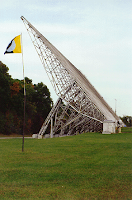Here is the top 10 controversial pieces of evidence for extraterrestrial life...
 1. 1976, The Viking Mars landers detect chemical signatures indicative of life
1. 1976, The Viking Mars landers detect chemical signatures indicative of life
Tests performed on Martian soil samples by NASA's Viking landers hinted at chemical evidence of life. One experiment mixed soil with radioactive-carbon-labelled nutrients and then tested for the production of radioactive methane gas.
The test reported a positive result. The production of radioactive methane suggested that something in the soil was metabolising the nutrients and producing radioactive gas. But other experiments on board failed to find any evidence of life, so NASA declared the result a false positive.
Despite that, one of the original scientists - and others who have since re-analysed the data - still stand by the finding. They argue that the other experiments on board were ill-equipped to search for evidence of the organic molecules - a key indicator of life.
 2. 1977, The unexplained extraterrestrial "Wow!" signal is detected by an Ohio State University radio telescope
2. 1977, The unexplained extraterrestrial "Wow!" signal is detected by an Ohio State University radio telescope
In August 1977 an Ohio State University radio telescope detected an unusual pulse of radiation from somewhere near the constellation Sagittarius. The 37-second-long signal was so startling that an astronomer monitoring the data scrawled "Wow!" on the telescope's printout.
The signal was within the band of radio frequencies where transmissions are internationally banned on Earth. Furthermore, natural sources of radiation from space usually cover a wider range of frequencies.
As the nearest star in that direction is 220 million light years away, either a massive astronomical event - or intelligent aliens with a very powerful transmitter would have had to have created it. The signal remains unexplained.
 3. 1996, Martian "fossils" are discovered in meteorite ALH84001 from Antarctica
3. 1996, Martian "fossils" are discovered in meteorite ALH84001 from Antarctica
NASA scientists controversially announced in 1996 that they had found what appeared to be fossilised microbes in a potato-shaped lump of Martian rock. The meteorite was probably blasted off the surface of Mars in a collision, and wandered the solar system for some 15 million years, before plummeting to Antarctica, where it was discovered in 1984.
Careful analysis revealed that the rock contained organic molecules and tiny specs of the mineral magnetite, sometimes found in Earth bacteria. Under the electron microscope, NASA researchers also claimed to have spotted signs of "nanobacteria".
But since then much of the evidence has been challenged. Other experts have suggested that the particles of magnetite were not so similar to those found in bacteria after all, and that contaminants from Earth are the source of the organic molecules. A 2003 study also showed how crystals that resemble nanobacteria could be grown in the laboratory by chemical processes.
 4. 2001, More rigorous calculations connected to the 1960s "Drake equation" suggests that our galaxy may contain hundreds of thousands of life-bearing planets
4. 2001, More rigorous calculations connected to the 1960s "Drake equation" suggests that our galaxy may contain hundreds of thousands of life-bearing planets
In 1961 US radio astronomer Frank Drake developed an equation to help estimate the number of planets hosting intelligent life - and capable of communicating with us - in the galaxy.
The Drake equation multiplies together seven factors including: the formation rate of stars like our Sun, the fraction of Earth-like planets and the fraction of those on which life develops. Many of these figures are open to wide debate, but Drake himself estimates the final number of communicating civilisations in the galaxy to be about 10,000.
In 2001, a more rigorous estimate of the number of life-bearing planets in the galaxy - using new data and theories - came up with a figure of hundreds of thousands. For the first time, the researchers estimated how many planets might lie in the "habitable zone" around stars, where water is liquid and photosynthesis possible. The results suggest that an inhabited Earth-like planet could be as little as a few hundred light years away.